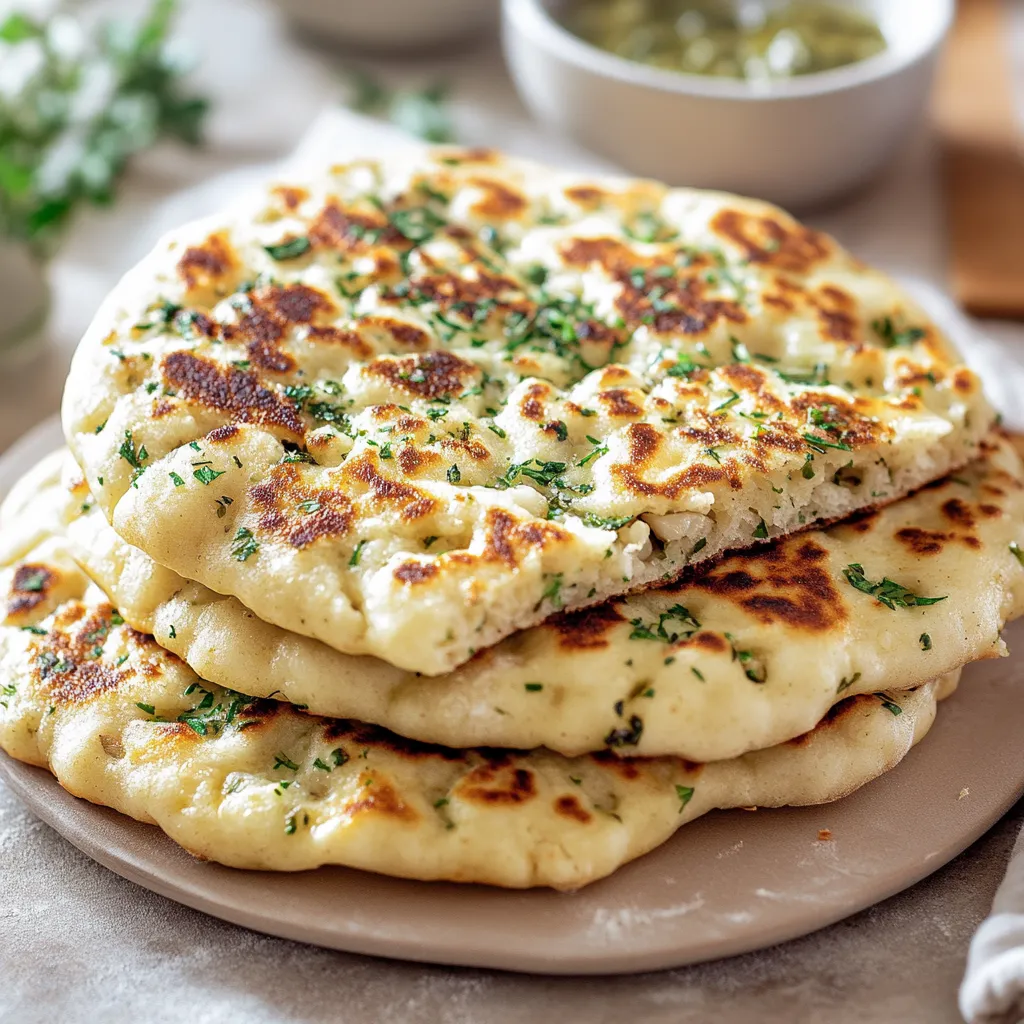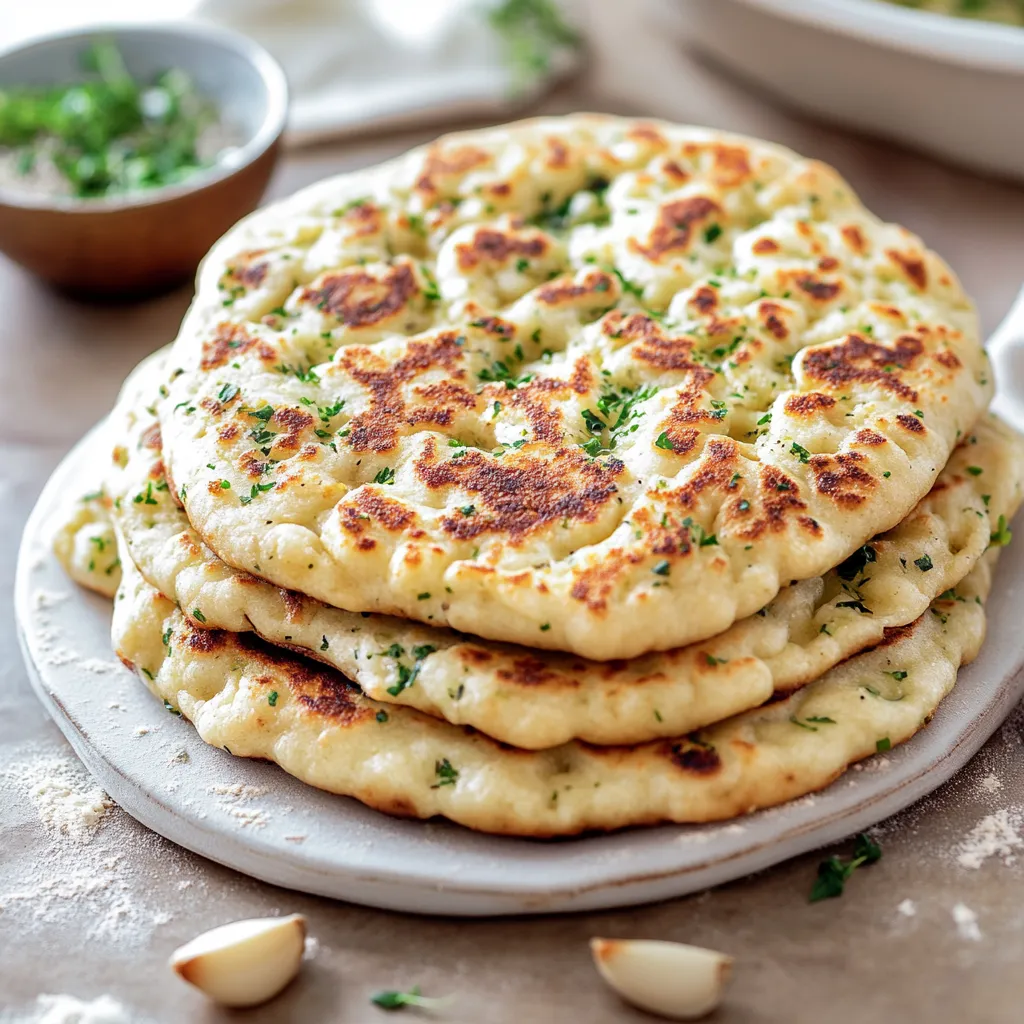 Pin it
Pin it
There's something deeply comforting about tearing into a warm, homemade flatbread. This garlic and herb flatbread delivers that experience with very little effort—no yeast, no proofing, and no oven required. Just a handful of pantry staples, a good skillet, and a few fresh herbs are all it takes to turn your meal into something special. Whether you’re pairing it with a bowl of creamy soup or using it to wrap roasted veggies or grilled chicken, this recipe has earned its spot as a weekly staple in my kitchen.
This flatbread surprised me the first time I made it. I was expecting something serviceable, maybe a little dense—but what I got was a soft, flavorful round with golden edges and a warm chew. The aroma of garlic in olive oil mixing with the steam rising off the skillet filled the whole kitchen. My husband couldn’t stop picking at them straight from the cooling rack, and now we make a double batch almost every time.
Essential Ingredients and How to Pick the Best Ones
- All-Purpose Flour: This gives the flatbread structure without making it too chewy. I prefer unbleached flour for a slightly richer flavor.
- Baking Powder: Acts as the leavening agent to give these breads their puff without yeast. Make sure it’s fresh—check the date on the can.
- Salt: A good balance is key. I stick with fine sea salt so it mixes evenly through the dough.
- Fresh Herbs (Chives & Parsley): These brighten the dough with fresh, green flavor. Use freshly chopped herbs—avoid the dried kind here.
- Greek Yogurt: Adds moisture and tenderness. Full-fat works best for flavor and softness, but 2% is fine too.
- Olive Oil: For flavor and for brushing. Use a decent quality extra virgin olive oil, especially for brushing at the end.
- Garlic: Freshly minced or grated garlic gets mellow and fragrant as it heats in the pan. One clove goes a long way here.
- Water: Just a tablespoon to help bring the dough together. Add a drop more if it feels too dry.
Each ingredient in this dough has a job. Over the years, I’ve realized just how much quality makes a difference. When I switched to using fresh herbs and full-fat yogurt, the texture changed dramatically—softer, richer, and more flavorful. These flatbreads now rival any I’ve had at restaurants.
Step-by-Step Instructions for Perfect Garlic Herb Flatbread
 Pin it
Pin it
- Step 1: Mix the Dry and Wet Ingredients
- In a large bowl, whisk the flour, baking powder, salt, and herbs together. You want an even distribution of herbs so each bite is flavored. In a smaller bowl, stir the olive oil and garlic together. Pour the yogurt, garlic-oil mixture, and water into the dry mix. Stir until the dough comes together into a soft, slightly tacky ball. If it’s too sticky, dust it with a little flour—if it feels dry, add a few drops of water.
- Step 2: Divide and Shape
- Turn the dough onto a lightly floured counter. Cut it into six roughly equal pieces and roll each into a smooth ball. Press each ball into a disk with your fingers, then use a rolling pin (or even your hands) to flatten it into a 6–7 inch round. Don’t worry about perfect circles—this is a rustic bread. Lay them on a parchment-lined plate while your skillet heats.
- Step 3: Cook the Flatbread
- Preheat a nonstick or cast-iron skillet over medium heat. When hot, brush one side of a dough round with olive oil and place it oil-side down in the skillet. Let it cook for about 90 seconds—watch for bubbles to form and the bottom to become golden. Brush the top with oil, flip it, and cook the second side for another minute or so. It should be lightly golden with a few darker spots. Stack them on a plate lined with a clean towel as you go to keep them warm.
- Step 4: Finish with a Final Brush and Serve
- Once all the flatbreads are cooked, brush them again with olive oil and sprinkle extra chopped herbs if you like. Serve warm. These go beautifully with lentil soup, tomato bisque, Greek salads, or just plain with a bit of hummus or tzatziki.
I’ve tried many versions of flatbread, but this one always stands out because of the yogurt. It creates such a lovely softness and a little tang. My kids love it spread with herbed cream cheese or used as the base for mini pizzas. I even keep a batch in the freezer for lunchbox wraps.
Ways to Use This Garlic Herb Flatbread
Flatbread is endlessly adaptable. If you have leftovers, here’s what to do:
- Tear it into large pieces for dipping in soups or stews
- Use it as a wrap for grilled chicken, falafel, or roasted vegetables
- Toast it and slice it into wedges for a homemade chip substitute
- Turn it into a flatbread pizza with tomato sauce, mozzarella, and whatever toppings you love
I like to layer leftovers with grilled halloumi, cucumbers, and a drizzle of lemon tahini. It makes such a satisfying lunch.
Storage and Reheating
- Store in a zip-top bag at room temperature for up to 2 days
- Reheat in a dry skillet for a minute on each side to bring back the warmth and softness
- Freeze in layers between parchment paper and reheat straight from frozen
Sometimes I double the batch and store half in the freezer. It’s my trick for getting dinner on the table fast when I’m short on time.
 Pin it
Pin it
Making flatbread this way has become a ritual in our home. I’ve taught both my daughters how to make it, and now it’s a recipe they request when we’re all gathered in the kitchen. There’s something grounding about forming the dough with your hands and watching it puff up in the pan.
